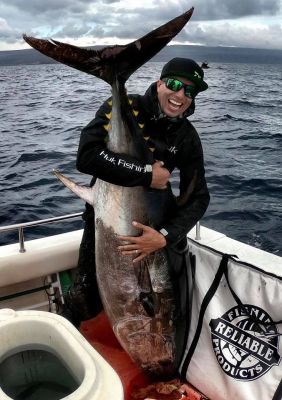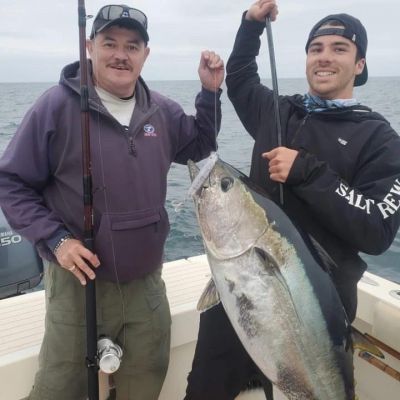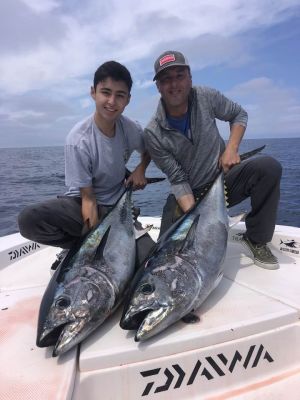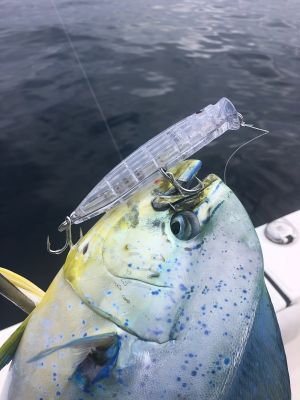The time is coming for one of the best bites in saltwater fishing, using big topwaters for Yellowfin, Bluefin, and Dorado. All Harbors Charter's Captain Gerry Mahieu anxiously awaits this great bite every year, which generally runs between July and October. It's a furious, "run and gun" style of fishing that produces insane topwater bites and hard-fighting fish.
Mahieu shared some insight on how it's done and information on the gear that he trusts to land these aggressive fish with artificials.
Timing the bite
It's already happening further south but slowly coming towards where Mahieu typically takes clients, typically around Long Beach or to Catalina Island, anywhere as close as three miles offshore to distances up to 50 miles out as they target ridges and seamounts.
"It started a little later this year and we have a good El Niño season, so it should run into November this year," he said. "We catch Yellowfin and Bluefin as well as Dorado and you can catch them with bait or trolling, but topwater fishing is my favorite thing to do."
The biggest key with the bite is simply finding the baitfish that attract these predators. "We do a lot of looking for activity, whether it's the birds or whales, to find where the bait is," he said. "A lot of these areas we'll find when the tide isn't right, but we'll mark those places and return when it is. It can be low or high; it just has to be a slack tide."
Gearing up for topwater action
For freshwater bass anglers who love topwater fishing, this saltwater method will be of interest to you. Mahieu capitalizes on this extremely fun way to fish using similar but very beefed-up baits.
His company is Clear Choice Lures and they make several baits developed especially for this type of fishing. The GHOST 150 Clear Popper is the most popular, but there is also a 130 and 170 size. Another great option is the Tuna Propper, a plopping-style topwater that comes in 140 and 160 sizes.
"All of the baits are super heavy-duty with 5X trebles; they're bulletproof," adds Mahieu.
He needs bulked-up gear to fish these jumbo topwaters and battle the fish and opts for a Daiwa Lexa 400 with the T-Wing system. It's a solid reel that casts exceptionally well, something Mahieu says is critical.
"It's a smaller profile reel and ergonomically, it feels great in your hands," he said. "It also casts a mile because of the T-Wing system and that's very important because you might not get a lot of opportunities in a day when they are up on the surface and 'foaming,' so every chance you get counts. I like to position the boat upwind and cast downwind to get the best opportunities to catch them on top."
For rods, he uses the Daiwa Winn Proteus, either the 8-foot, 1-inch medium heavy, or heavy, depending on the size of the fish. "For yellowfin, the medium-heavy is fine, but when catching 80 to 150-pound Bluefin, the heavy is a much better rod," he shared. "The length of the rod is great because you can get a long-distance cast because the top third has some bend to it. The other section of the rod, especially the heavy, is a meat stick; you can pull on those fish and land them quicker."
Mahieu prefers 65 to 80-pound Daiwa J-Braid X8 in the grey light color, with a leader of 80-pound J-Fluoro fluorocarbon leader joined by an RP or Albright Knot.
"The braid has excellent abrasion resistance and withstands those big tail slaps from tuna," he said. "I like 65-pound most of the time just for longer casting distances because with 80-pound, you don't get near the amount of line on your reels. But, sometimes, you need the heavier line for the really big fish."
He opts for the fluorocarbon leader to aid with working his bait, as the stiff 80-pound line will keep the line out in front of the treble hooks as he or his clients are working the bait.
"I'll use a 4 or 5-foot leader, just long enough where it doesn't go into the guides," he said. "The fluorocarbon keeps the bait from foul hooking on the line, so you don't have any wasted casts. It's also very strong and resilient."
There are many ways to catch these highly sought-after pelagics, but the topwater bite has to be the most exciting way to do it. It's an extreme way to fish for them with massive blowups and quick bursts of action, which keeps Mahieu and others coming back for more.






 Advertising
Advertising